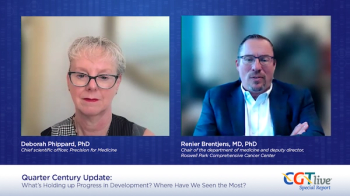
Ula V. Jurkunas, MD, on Developing CALEC Transplant for Limbal Stem Cell Deficiency
The associate professor of ophthalmology at Harvard Medical School discussed investigational corneal transplant therapy.
"To improve upon the existing procedures, we have developed a technology where only a very small biopsy, such as 1 to 2 millimeters, can be taken from the healthy eye, and the cells are grown in the lab [before transplanting to the diseased eye] and then that way the diseased eye is rehabilitated.”
Limbal stem cell (LSC) deficiency can cause permanent vision loss, pain, and discomfort. The current standard of vision rehabilitation, artificial corneal transplant, requires limbal cells and a healthy eye surface. Chemical burns, other eye injuries, infection, or hereditary diseases can cause unilateral or bilateral LSC deficiency.
A phase 1/2 trial (NCT02592330) being conducted across centers including Massachusetts Eye and Ear Institute, Boston Children’s Hospital, JAEB Center for Health Research, and Dana-Farber Cancer Institute is evaluating cultivated autologous limbal epithelial cells (CALEC) in 4 patients with unilateral LSC deficiency. CALEC transplant includes removing stem cells from the patient’s healthy eye via a small biopsy, expanding and growing the cells on a graft before transplantation.
Patients were followed for 12 months after transplant and experienced restored cornea surfaces, with 2 able to undergo a corneal transplant and 2 reporting significant improvements in vision without additional treatment. These positive feasibility data, which were recently published in Scientific Advances, has prompted the trial to open a second recruitment phase which will include 18-month follow-up for the treated patients as well as a larger cohort.
CGTLive spoke with first author Ula V. Jurkunas, MD, associate professor of ophthalmology, Harvard Medical School, and Mass Eye and Ear, to learn more about LSC deficiency and how it affects patients. She discussed the investigational CALEC transplant.
REFERENCE
Jurkunas UV, Yin J, Johns LK, et al. Cultivated autologous limbal epithelial cell (CALEC) transplantation: Development of manufacturing process and clinical evaluation of feasibility and safety. Sci. Adv. (2023) 9, eadg6470.doi: 10.1126/sciadv.adg6470
Newsletter
Stay at the forefront of cutting-edge science with CGT—your direct line to expert insights, breakthrough data, and real-time coverage of the latest advancements in cell and gene therapy.











































